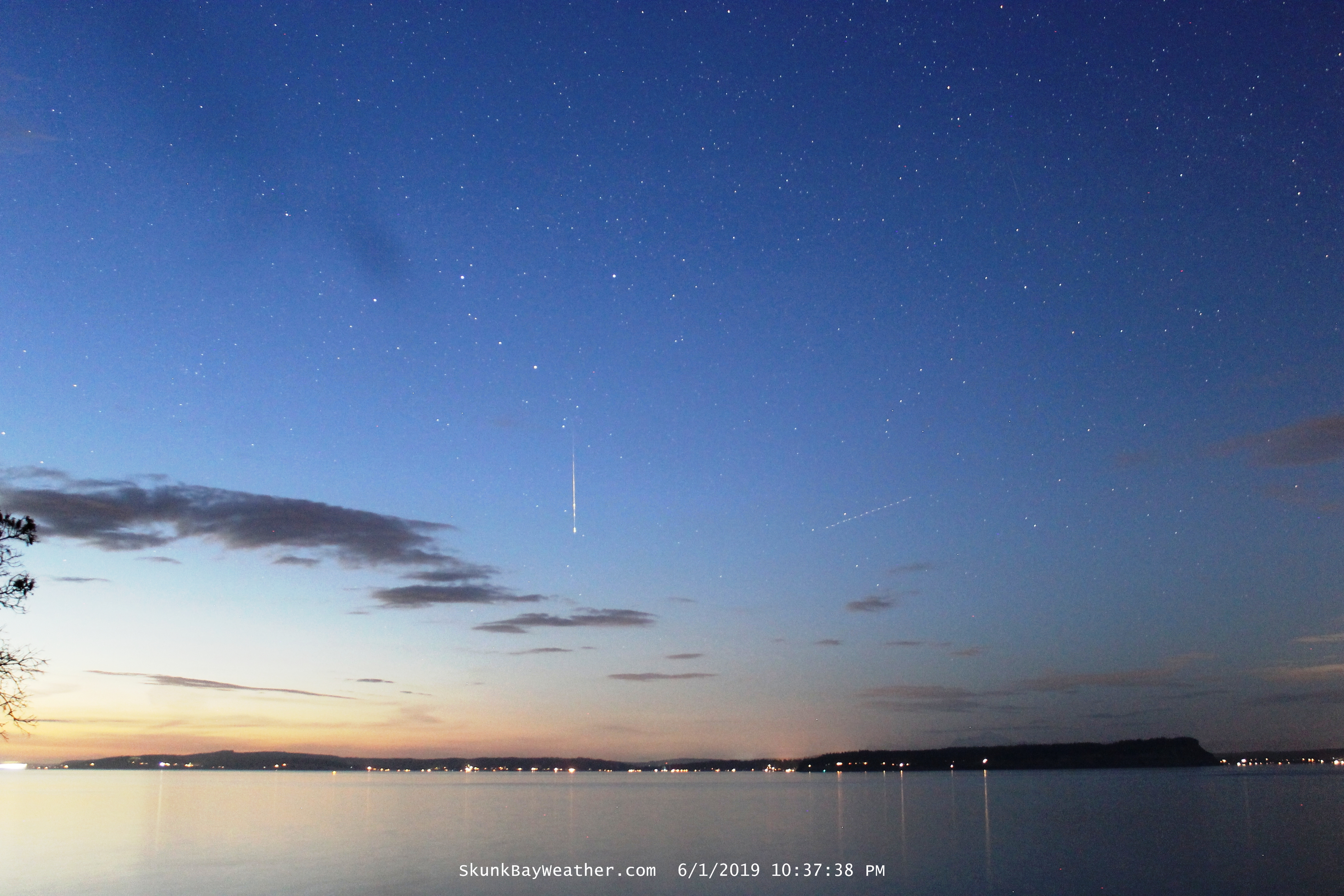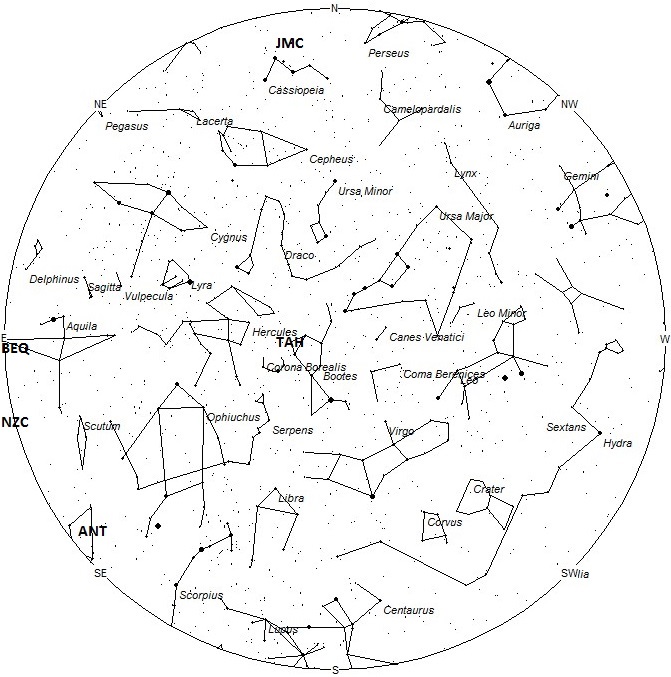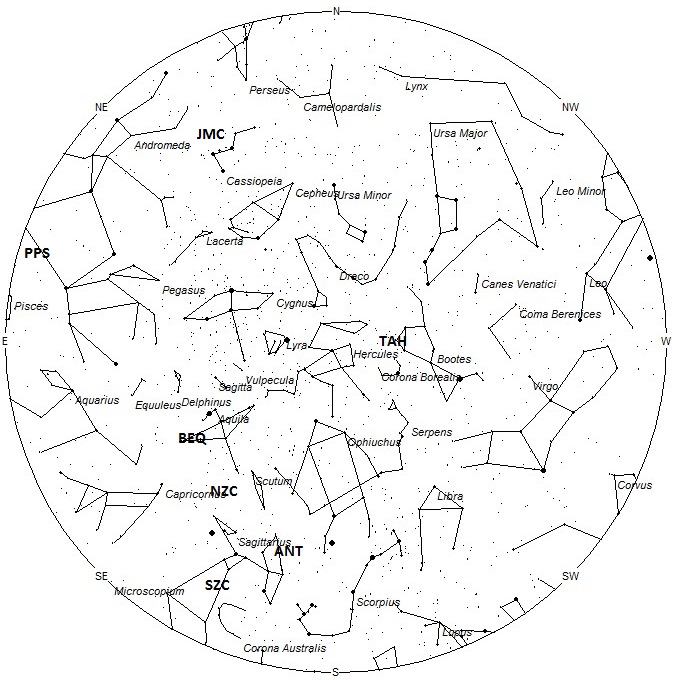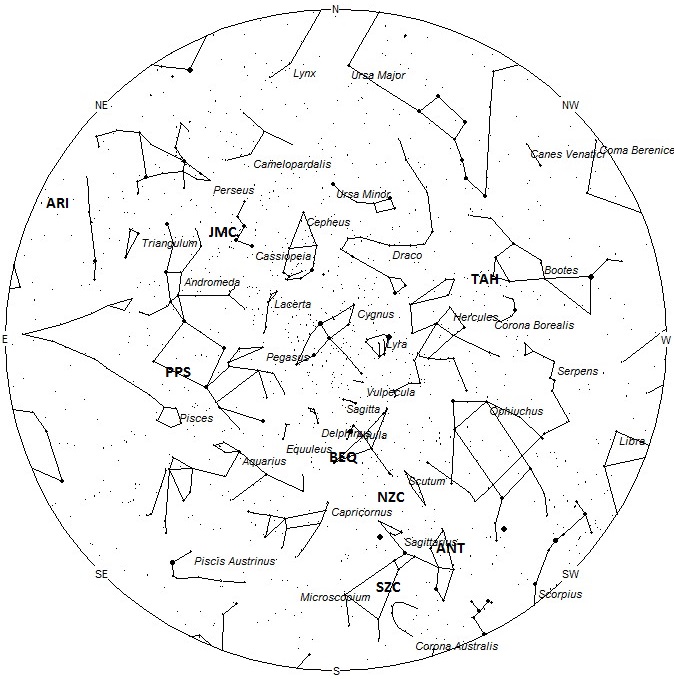
During this period the moon reaches its first quarter phase on Monday June 10th. At this time the moon is located 90 degrees east of the sun and sets near 0200 local daylight saving time (LDST). As the week progresses, the waxing gibbous moon will set later in the morning with each passing night, reducing the window of dark skies available. The estimated total hourly meteor rates for evening observers this week is near 3 for those viewing from the northern hemisphere and 4 for those located south of the equator. For morning observers the estimated total hourly rates should be near 8 as seen from mid-northern latitudes (45N) and 13 as seen from tropical southern locations (25S). The actual rates will also depend on factors such as personal light and motion perception, local weather conditions, alertness and experience in watching meteor activity. Evening rates are reduced by moonlight during this period. Note that the hourly rates listed below are estimates as viewed from dark sky sites away from urban light sources. Observers viewing from urban areas will see less activity as only the brightest meteors will be visible from such locations.
The radiant (the area of the sky where meteors appear to shoot from) positions and rates listed below are exact for Saturday night/Sunday morning June 8/9. These positions do not change greatly day to day so the listed coordinates may be used during this entire period. Most star atlases (available at science stores and planetariums) will provide maps with grid lines of the celestial coordinates so that you may find out exactly where these positions are located in the sky. A planisphere or computer planetarium program is also useful in showing the sky at any time of night on any date of the year. Activity from each radiant is best seen when it is positioned highest in the sky, either due north or south along the meridian, depending on your latitude. It must be remembered that meteor activity is rarely seen at the radiant position. Rather they shoot outwards from the radiant so it is best to center your field of view so that the radiant lies at the edge and not the center. Viewing there will allow you to easily trace the path of each meteor back to the radiant (if it is a shower member) or in another direction if it is a sporadic. Meteor activity is not seen from radiants that are located below the horizon. The positions below are listed in a west to east manner in order of right ascension (celestial longitude). The positions listed first are located further west therefore are accessible earlier in the night while those listed further down the list rise later in the night.
These sources of meteoric activity are expected to be active this week.
The tau Herculids (TAH) are an irregular shower not active every year. They are best known for being associated with comet Schwassmann-Wachmann 3 and the strong display seen in 1930. Due to recent activity from the comet, this shower could produce more activity in the upcoming decade. The Earth could start encountering particles from Schwassmann-Wachmann 3 around May 14. Maximum activity is predicted to occur on June 3rd. The radiant currently lies near 15:12 (233) +38. This area of the sky is located on the Bootes/Corona Borealis border, 1 degree northeast of the 3rd magnitude star known as Alkalurops (μ1 Boötis). This is not that close to the star tau Herculis, for which this shower is named. Apparently the discoverers of this display placed the radiant further east toward Corona Borealis and Hercules. It’s also possible that earlier displays of this shower did have a radiant within the borders of Hercules but that recent activity has a different radiant. This area of the sky is best placed near 00:00 LDST, when it lies highest above the northern horizon. With an entry velocity of 15 km/sec., the average tau Herculid meteor would be of very slow velocity.
The center of the large Anthelion (ANT) radiant is currently located at 18:04 (271) -23. This position lies in western Sagittarius, 5 degrees northwest of the 3rd magnitude star known as Kaus Borealis (lambda Sagittarii). Due to the large size of this radiant, anthelion activity may also appear from southeastern Ophiuchus, southern Serpens Cauda, Scutum, southeastern Scorpius, as well as western Sagittarius. This radiant is best placed near 0200 LDST, when it lies on the meridian and is located highest in the sky. Rates at this time should be near 2 per hour as seen from mid-northern latitudes (45 N) and 3 per hour as seen from the southern tropics (S 25). With an entry velocity of 30 km/sec., the average anthelion meteor would be of slow velocity.
The Northern June Aquilids (NZC) are active from a radiant located at 19:08 (287) -12. This area of the sky is located on the border of Aquila and Sagittarius, 7 degrees south of the 3rd magnitude star known as Al Thalimain Prior (lambda Aquilae). This radiant is best placed near 0300 LDST, when it lies on the meridian and is located highest in the sky. With the night of maximum nearly a month away, hourly rates at this time will be less than 1 no matter your location. With an entry velocity of 38 km/sec., the average meteor from this source would be of medium-slow velocity. An interesting fact about this source is that it may be related to the Northern delta Aquariids of August. Where and when this source ends coincides with the start and position of the Northern delta Aquariids.
The Southern June Aquilids (SZC) were discovered by G. Gartrell and W. G. Elford, in their study of Southern Hemisphere meteor streams. This stream is active from June 9 through July 17 with maximum activity occurring on July 6. The radiant is currently located at 19:24 (291) -36. This area of the sky is actually located in southeastern Sagittarius, 4 degrees northeast of the 4th magnitude star known as gamma Coronae Australis. This radiant is best placed near 0400 LDST, when it lies on the meridian and is located highest in the sky. With the July 6th maximum still a month away, hourly rates at this time will be less than 1 no matter your location. With an entry velocity of 39 km/sec., the average meteor from this source would be of medium-slow velocity.
The beta Equulids (BEQ) were discovered by Dr. Peter Brown and associates using data from the Canadian Meteor Orbit Radar (CMOR) installation. These meteors are active from June 7-30 with maximum activity occurring on June 15th. The radiant position currently lies at 19:42 (296) -01. This area of the sky lies in central Aquila, 1 degree east of the 4th magnitude star known as Al Thalimain Posterior (iota Aquilae). This radiant is best placed near 0400 LDST, when it lies on the meridian and is located highest in the sky. Hourly rates are expected to be less than 1, no matter your location. With an entry velocity of 33 kilometers per second, a majority of these meteors will appear to move with medium-slow velocities.
The June mu Cassiopeiids (JMC) were also discovered by Dr, Peter Brown and associates using data from the Canadian Meteor Orbit Radar (CMOR) installation. These meteors are active from May 18-June 15, with maximum activity occurring on June 8th. The radiant position currently lies at 01:12 (018) +56. This area of the sky lies in southern Cassiopeia, near the spot occupied by the 4th magnitude star known as Marfak (theta Cassiopeiae). These meteors are best seen near during the last dark hour of the night when the radiant just barely clears the northern horizon for observers located in the southern tropics. These meteors are better seen from the northern hemisphere where the radiant rises higher into the sky before the start of morning twilight. Hourly rates are expected to be near 1 as seen from the northern hemisphere and less than 1 as seen from the southern tropics. With an entry velocity of 42 kilometers per second, a majority of these meteors will appear to move with medium velocities.
The phi Piscids (PPS) are another discovery by Dr. Peter Brown and associates using data from the Canadian Meteor Orbit Radar (CMOR) installation. These meteors are active from June 8-August 02 with maximum activity occurring on July 5th. The radiant position currently lies at 23:42 (355) +15. This area of the sky lies in southern Pegasus, lying directly between the two bright stars forming the southern side of the “Great Square of Pegasus” (Algenib (gamma Pegasi) and Markab (alpha Pegasi)). These meteors are best seen near during the last dark hour of the night when the radiant lies highest in a dark sky. With the date of maximum activity a month away, hourly rates are expected to be less than 1 no matter your location. With an entry velocity of 67 kilometers per second, a majority of these meteors will appear to move with swift velocities.
The Daytime Arietids (ARI) are active from May 22-June 24 with maximum activity occurring on the June 8th. These meteors are difficult to catch as the radiant only lies 30 degrees west of the sun. Therefore the only time these meteors are visible is during the last dark hour before dawn. The radiant is currently located at 03:02 (046) +25. This area of the sky is located in eastern Aries, 5 degrees north of the 4th magnitude star known as Botein (delta Arietis). Current rates are expected to be less than 1 no matter your location. With an entry velocity of 41 km/sec., the average meteor from this source would be of medium velocity.
As seen from mid-northern hemisphere (45N), morning rates would be near 6 per hour as seen from rural observing sites and 1 per hour during the evening hours. As seen from the tropical southern latitudes (25S), one would expect to see approximately 11 sporadic meteors per hour during the last hour before dawn as seen from rural observing sites. Evening rates would be near 3 per hour. Locations between these two extremes would see activity between the listed figures. Evening rates are reduced during this period due to bright moonlight.
The list below offers the information from above in tabular form. Rates and positions are exact for Saturday night/Sunday morning except where noted in the shower descriptions.
| SHOWER | DATE OF MAXIMUM ACTIVITY | CELESTIAL POSITION | ENTRY VELOCITY | CULMINATION | HOURLY RATE | CLASS |
| RA (RA in Deg.) DEC | Km/Sec | Local Daylight Saving Time | North-South | |||
| tau Herculids (TAH) | Jun 03 | 15:12 (228) +40 | 15 | 00:00 | <1 – <1 | III |
| Anthelion (ANT) | – | 17:36 (264) -23 | 30 | 02:00 | 2 – 3 | II |
| Northern June Aquilids (NZC) | Jul 03 | 18:36 (279) -14 | 41 | 03:00 | <1 – <1 | IV |
| Southern June Aquilids (SZC) | Jul 06 | 19:24 (291) -36 | 39 | 04:00 | <1 – <1 | IV |
| beta Equulids (BEQ | Jun 15 | 19:42 (296) -01 | 33 | 04:00 | <1 – <1 | IV |
| phi Piscids (PPS) | Jul 05 | 23:42 (355) +15 | 67 | 08:00 | <1 – <1 | IV |
| June mu Cassiopeiids (JMC) | Jun 08 | 00:36 (009) +51 | 42 | 09:00 | 1 – <1 | IV |
| Daytime Arietids (ARI) | Jun 08 | 03:02 (046) +25 | 41 | 11:00 | <1 – <1 | II |
 American Meteor Society
American Meteor Society



I have witness one of this and able to took photo of it